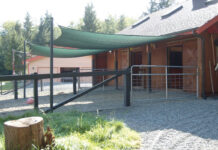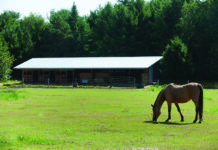The first on-site wiring will be covered cables strung across the ground and connected to an outside electric power box. Eventually, this is removed and all wiring will be underground, just as it is for your house. Because faulty wiring is the leading cause of horse barn fires, your electrical work should be done by a licensed professional and run through metal conduit to prevent animals from chewing on it.
Cut down the number of overhead electric boxes for stalls by having your electrician install them at the top of each partition so that one bulb shines into two stalls. You can also reduce your electric bill by using wall switches that turn on alternating light fixtures rather than all of them, or consider using fluorescent lighting, which is an inexpensive alternative to light bulbs.
Make a list of all the uses you may have for electric power, such as: halogen or mercury vapor lights on the barn’s exterior, clippers, heat lamps, heated buckets, water heaters, vacuums and vet equipment. Either on your own rough layout or an architect’s plans, specify where you want each power outlet and light fixture installed in your barn. Be as complete as possible because once finish walls go up, it’s much more difficult to make changes.





